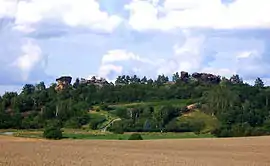Königstein (Westerhausen)
The Königstein is a 189 m high hill in the northern Harz Foreland in the German state of Saxony-Anhalt.[1] It is also known as the Kamelfelsen ("Camel Rocks") due to its unusually shaped sandstone rock formation.
| Königstein | |
|---|---|
 The Königstein from the south | |
| Highest point | |
| Elevation | 189 m (620 ft) |
| Coordinates | 51°48′46″N 11°03′01″E |
| Geography | |
 Königstein | |
| Parent range | Harz Mountains |
Location and area
The Königstein lies in the northern Harz Foreland, northwest of Westerhausen (near Quedlinburg) on the road towards Börnecke. Its neighbouring hill to the northwest is the 178 m high Jätchenberg. The federal road B 6n runs by to the north. The Königstein is a ridge running from northwest to southeast. Its northeastern flank is relatively steep, but its southwestern slopes fall away much more gently. It is mostly covered in deciduous forest.[1] The vineyard on the southern slopes of the Königstein belongs to the Saale-Unstrut wine-growing area.[2][3] The crest of the ridge is dominated by the striking Kamelfelsen rocks, whose name derives from their shape: seen from the south or north they are supposed to resemble two camels lying down.[4]
The Kamelfelsen
The Kamelfelsen consist of hardened sandstone, which also has very soft and crumbly sections. This rock formation, like the well-known Teufelsmauer, was created as a result of the formation of the fault-block mountains of the Harz and the earth movements in the northern Harz Foreland resulting from it. Like the nearby Teufelsmauer, the Königstein is a "rib" of harder rock (Schichtrippe) from the Lower Cretaceous. The Königstein was first placed under protection as a geological feature in 1932 and has been registered as a natural monument since 1997.[4][5] There are several climbing routes on the Kamelfelsen up to climbing grade VIIIb (Saxon grading).[6]
History
The Königstein was probably used during the Stone Age as a cult site, and Germanic summer solstice celebrations may have taken place here,.[7] The "sun discs" (Sonnenräder) on the rocks - circular shapes cut into the rock, about 1 metre or more in diameter which are distributed around the lower part of the rocks on their northern side - are artifacts resulting from the production of millstones.[7][8] There are also several archaeological sites in the immediate vicinity. The last important find was made during the construction of the German federal road B 6n which runs close by the site.[9]
References
- Bundesamt für Kartographie und Geodäsie, Landesamt für Vermessung und Geoinformation Sachsen-Anhalt: Digitale Topographische Karte 1:50 000, Sachsen-Anhalt Viewer Archived 2012-12-04 at Archive.today, accessed on 29 November 2010 (German)
- "Weinberge/Königstein" (in German). harzer-weingut.de. Archived from the original on 2010-05-26. Retrieved 29 Nov 2010.
- "Weinanbau Saale-Unstrut - Weinlagen und Klima" (in German). Weinbauverband Saale-Unstrut. Archived from the original on 19 July 2011. Retrieved 29 Nov 2010.
- "Kamelfelsen" (in German). ostharz.info. Archived from the original on 2015-01-24. Retrieved 29 Nov 2010.
- "Naturschutz in der Gemarkung Westerhausen" (in German). Verein für Heimatgeschichte und Naturschutz Westerhausen. Retrieved 29 Nov 2010.
- "Kamelfelsen" (in German). climbing.de. Retrieved 29 Nov 2010.
- "Vom Königstein zur Königspfalz" (in German). Regionalverband Harz. Retrieved 29 Nov 2010.
- Reinboth, Fritz (2005). Die "Sonnenräder" vom Königstein bei Westerhausen: Kultgeräte oder Mühlsteine? Unser Harz 2005, H. 7, pp. 125–128 (German)
- "Königstein" (in German). westerhausen-info.de. Retrieved 29 Nov 2010.
External links
- The Königstein near Westerhausen at harzlife.de (in German)